By Gary Nowitz / Blueprints for Senior Living newsletter, August 2016
“Universal Design” is a relatively new concept in architecture. Universal Design initiatives seek to create buildings that feature not only easy access but also especially-designed equipment and accessories that meet the needs of the broadest possible range of citizens, including elderly and disabled individuals. Further, when it comes to built-in or wall-mounted equipment, manufacturers are dramatically improving the ease-of-use aspects of items ranging from toilets and sinks to kitchen cabinets and countertops. In other words, both architects and manufacturers are finally recognizing the need to accommodate a population characterized by burgeoning numbers of elderly and people with all manner of physical abilities.
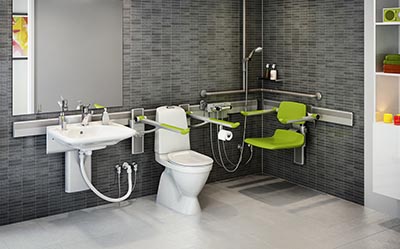
Photo courtesy of Pressalit Care.
Among the latest trends in bathroom and kitchen equipment are new mounting technologies that enable residents to quickly and easily adjust the height and wall position of fixtures such as sinks, shower chairs, support arms, and even items such as kitchen cabinets and countertops. As well, adjustable toilets are now emerging onto the market that are pushbutton height-adjustable to facilitate wheelchair transfers and other functions required by people of varying mobility.
What do these new technologies have to do with Universal Design? For a healthcare architect, the ability to slide a sink along a wall-mounted rail may help meet disability codes such as required by the Americans with Disabilities Act. The ability to easily reposition a bathroom sink horizontally and vertically, for example, may more easily accommodate wheelchair users in a confined area. Further, simply by selecting location-adjustable fixtures the architect may be achieving a number of Universal Design goals. For example, in elderly or assisted care housing each unit’s toilets, sinks, and shower accessories can now be easily repositioned to meet the precise height and location requirements of that individual. Given today’s population of elderly and/or physically challenged residents, these types of products are an ideal way for architects to meet the needs of a much broader range of people than when using conventional design criteria.
What can universal design do for individual residents?
Self-sufficiency is extremely important for elderly or disabled individuals who, over time, find themselves unable to perform certain basic tasks without the assistance of another person. Now, thanks to easy up-down-sideways adjustability, an individual might more easily transfer himself between toilet and wheelchair, for example, thereby improving self-esteem and feelings of self-sufficiency: Important considerations for every human being. Further, height-adjustable fixtures may reduce dependency on others, assuring a simple, cost-effective solution that helps to enhance self-worth and improve the overall quality of life of users. Another user benefit might include easier access to bathing equipment for house cleaning and sanitation purposes. The bottom line? Universal design greatly enhances the architect’s ability to accommodate the needs of multiple individuals who may have a vast array of different dependencies.
What are some examples of equipment used in universal design?
|
Sinks and shower fixtures – Sinks and other bathroom accessories such as wall-mounted shower seats and support arms can be mounted on attractive, high-strength aluminum rails that allow easy adjustment up, down, or sideways. Repositioning is controlled by simple easy to turn adjustment handles, enabling residents or maintenance personnel to adapt the layout of a bathroom to suit the varying size and mobility requirements of each individual user.
|
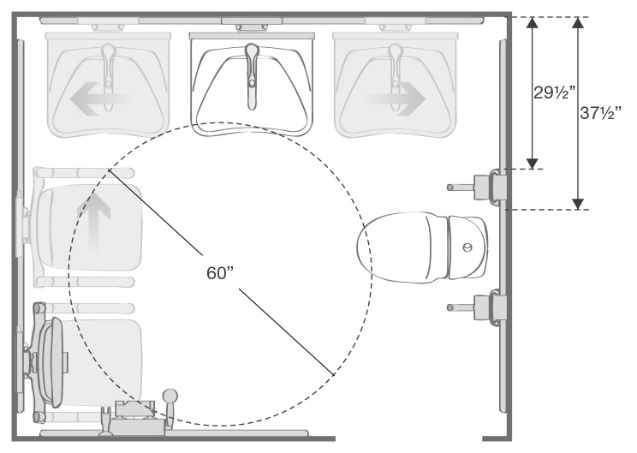
Photo courtesy of Pressalit Care.
|
|
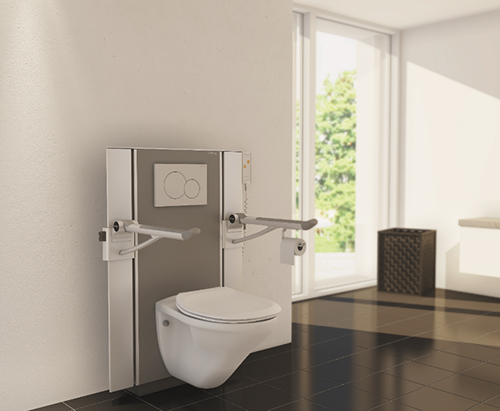
Photo courtesy of Pressalit Care.
|
Height adjustable toilets – Height adjustable toilets are mounted on an innovative adjustable track system that allows users to easily change a toilet’s elevation by up to approximately 15 inches (400 mm). The toilet’s height is controlled by either a manual hand-crank option or by a hand-held device that controls an electrically powered actuator. This means residents can position the toilet at their optimal desired height, even while seated on the toilet.
|
|
Height-adjustable kitchen cabinets and work surfaces – Height-adjustable kitchens have broad appeal for many people. Height-adjustable work surfaces and wall cabinets enable a variety of individuals and those with varying physical statures to work together simultaneously. Adjustable countertops are also valuable options in private residence kitchens, particularly where people of varying mobility or wheelchair users wish to participate in meal preparation and related activities.
|
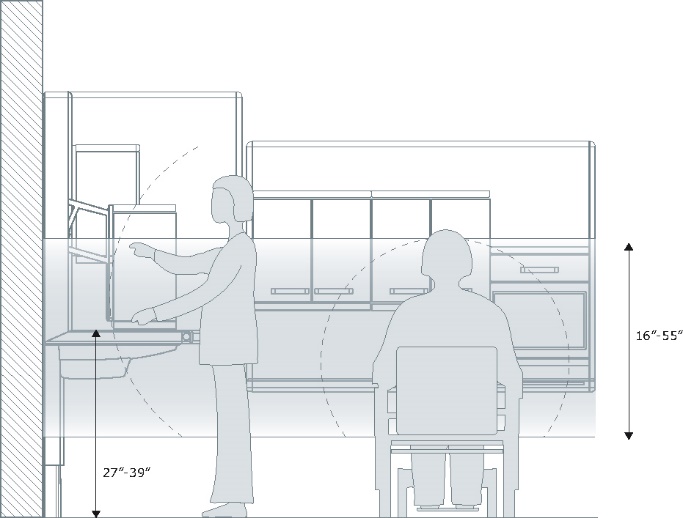
Photo courtesy of Pressalit Care.
|
Universal design in the future
In conclusion, greater flexibility in laying out rooms means greater ability to accommodate state and federal codes, professional guidelines, and individual owner preferences. As architects and room designers become more aware of these creative new solutions, they are designing living spaces that can be quickly and easily adjusted to each individual occupant. No longer will residents be forced to adapt to inconvenient, difficult-to-access sinks, toilets, countertops, support arms, changing tables, and numerous other wall-mounted items.
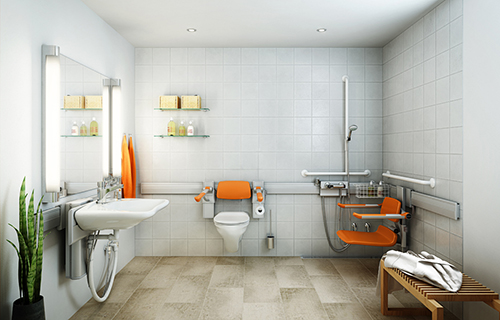
Photo courtesy of Pressalit Care.
______________________
About the author:
 |
Gary D. Nowitz is president of North American operations for
Pressalit Care of Ry, Denmark. Nowitz is responsible for establishment
of a comprehensive North American Sales and Service network as well as
introduction of the company’s family of innovative bathroom and kitchen
safety solutions into schools, homes, public buildings, and the
healthcare marketplace, including hospitals, long term care, rehab
facilities, and group homes. A native of Bridgeport, CT, Nowitz is
currently a resident of East Dennis, Massachusetts.
|
About Pressalit Care:
Pressalit Care is part of the Pressalit A/S, one of Europe’s leading manufacturers of bathroom and kitchen solutions for people with disabilities. The company designs and markets specialty products for installation in hospitals, nursing homes, rehab facilities and the home environments of physically disabled people. Additional business areas of Pressalit include Pressalit Seats, Europe’s leading supplier of toilet seats and bathroom accessories, and SaniScan, a leading manufacturer of seats and bathroom accessories. Pressalit Care’s North American headquarters is located in East Dennis, MA.